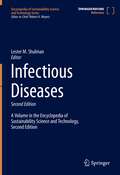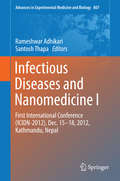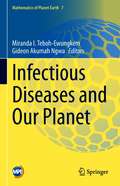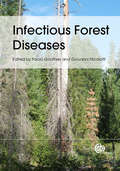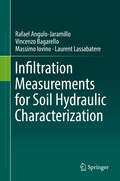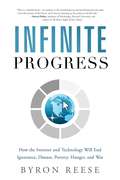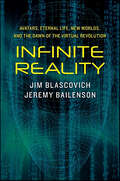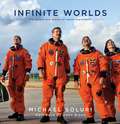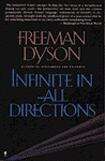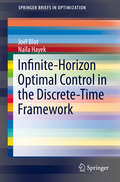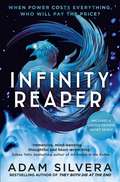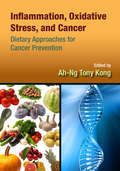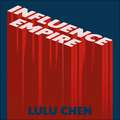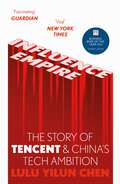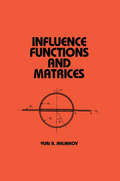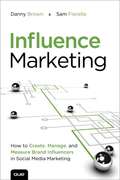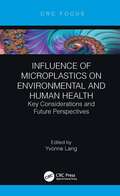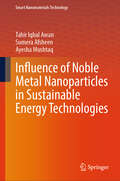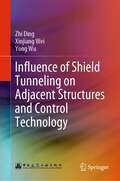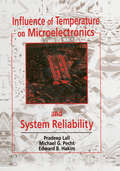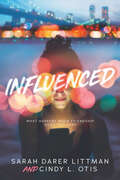- Table View
- List View
Infectious Diseases (Encyclopedia of Sustainability Science and Technology Series)
by Lester M. ShulmanThis volume on Infectious Diseases in an Encyclopedia of Sustainability Science and Technology (ESST) addresses the needs of health care providers and policy makers as well as scientists and engineers. Most of chapters in this volume deal with infectious diseases that directly affect humans, including the detailed characterization of specific pathogens, how they reproduce, how they are transmitted, and the means available to control, eliminate, or eradicate them. In this revised and updated second edition, the number of human infectious diseases covered has been significantly expanded. Other new chapters deal with current leading edge technologies for the diagnosis of pathogens; surveillance including environmental and syndromic surveillance for pathogens; requirements for quality assurance, quality control and the need for biological standards and controls to sustain high quality diagnosis and surveillance; the use of big data for personalized medicine; modeling infectious diseases; zoonotic and vector borne diseases; disease prevention with antibiotics, antivirals and vaccines; and factors that affect ecological balances leading to emergence of new diseases such as climate change and deforestation. Finally, infectious diseases that affect livestock and culture of plants for food, comfort and beauty are also addressed, since we must also consider them when discussing sustainability of humans in our ecosystem.
Infectious Diseases and Nanomedicine II
by Rameshwar Adhikari Santosh ThapaThe book addresses the interdisciplinary scientific approach for the systemic understanding of connections between major human diseases and their treatment regime by applying the tools and techniques of nanotechnology. It also highlights the interdisciplinary collaborative researches for innovation in Biomedical Sciences. The book is a second volume which presents collection of best papers presented in the First International Conference on Infectious Diseases and Nanomedicine held during Dec. 15-18, 2012 in Kathmandu, Nepal. The book focuses mainly on the topics: emerging infectious diseases; antimicrobial agents, vaccines and immunity; drug design, drug delivery and tissue engineering and nanomaterials and biomedical materials.
Infectious Diseases and Our Planet (Mathematics of Planet Earth #7)
by Miranda I. Teboh-Ewungkem Gideon Akumah NgwaThis book features recent research in mathematical modeling of indirectly and directly transmitted infectious diseases in humans, animals, and plants. It compiles nine not previously published studies that illustrate the dynamic spread of infectious diseases, offering a broad range of models to enrich understanding. It demonstrates the capability of mathematical modeling to capture disease spread and interaction dynamics as well as the complicating factors of various evolutionary processes. In addition, it presents applications to real-world disease control by commenting on key parameters and dominant pathways related to transmission. While aimed at early-graduate level students, the book can also provide insights to established researchers in that it presents a survey of current topics and methodologies in a constantly evolving field.
Infectious Forest Diseases
by Michael Wingfield Paolo Capretti Paolo Gonthier Richard Hamelin J Stenlid Bernard Slippers Tadeusz Kowalski Robert Mathiasen Robert Edmonds Rimvydas Vasaitis Michael Ostry Thomas Kirisits Marieka Gryzenhout Thomas Harrington Kathy Lewis Caroline Mohammed Libor Jankovsk Rosie Bradshaw Naoto Kamata Matteo Garbelotto Helen Griffiths Thomas Cech William Otrosina Giovanni Nicolotti Lilja Arija Roberto Danti Jean Guillaumin Daniel RiglingToday, forest health and the management of threats towards it are attracting more and more attention on a global scale. This book covers the most recent advances in the management of forest diseases, including the epidemiology and infection biology of forest pathogens, and forest protection based on integrated pest and disease management approaches. A comprehensive range of diseases caused by viruses, bacteria, fungi and other organisms are discussed in detail, making this book essential reading for forest managers and extension specialists. Written by recognised authorities in the subject of forest health, this book also provides a wealth of information useful for researchers and lecturers of forest pathology and ecology.
Infectious Forest Diseases
by Michael Wingfield Paolo Capretti Richard Hamelin J Stenlid Bernard Slippers Tadeusz Kowalski Robert Mathiasen Robert Edmonds Rimvydas Vasaitis Michael Ostry Thomas Kirisits Marieka Gryzenhout Thomas Harrington Kathy Lewis Caroline Mohammed Libor Jankovsk Rosie Bradshaw Naoto Kamata Matteo Garbelotto Helen Griffiths Thomas Cech William Otrosina Lilja Arija Roberto Danti Jean Guillaumin Daniel RiglingToday, forest health and the management of threats towards it are attracting more and more attention on a global scale. This book covers the most recent advances in the management of forest diseases, including the epidemiology and infection biology of forest pathogens, and forest protection based on integrated pest and disease management approaches. A comprehensive range of diseases caused by viruses, bacteria, fungi and other organisms are discussed in detail, making this book essential reading for forest managers and extension specialists. Written by recognised authorities in the subject of forest health, this book also provides a wealth of information useful for researchers and lecturers of forest pathology and ecology.
Infectious and Medical Waste Management
by Peter A. ReinhardtThis complete guide to infectious and medical waste management is required reading for everyone who handles, treats, transports, disposes of, or is responsible for this waste. Until now, no book has been written that explains in detail how to safely comply with the complex regulations and how to set up an effective infectious and medical waste program (including AIDS and Hepatitis B viruses) so the right decisions can be made. This valuable book gives you the expertise of the authors' combined 30 years' experience with this vital topic. Organized and presented in a clear, concise style-complete and practical-Infectious and Medical Waste Management covers every major and minor topic in this field: Medical Waste, Infectious Waste, Chemical Waste, and Radioactive Waste-everything you need to know is thoroughly covered. Presents waste audit plan organized by: collection, containers, spills, storage and processing, transportation, treatment, disposal, personnel and management.
Infermieraaa!!
by Sarah Jane Butfield Michela TettoSara Jane ha solo sedici anni quando decide di diventare un'infermiera; fino ad allora non ha mai avuto alcuna ambizione lavorativa, voleva soltanto finire la scuola, lavorare come cassiera ai supermercati Woolsworth e sposarsi. Poi tutto cambia, e lei si ritrova a indossare un’uniforme rosa fluo, e a studiare per entrare in una scuola d’infermieristica. Cos’ha provocato questo sorprendente cambio di direzione? Cosa succede quando va via di casa e va a vivere in città con una coinquilina che ama solo divertirsi? Ma la vera domanda è: lei è tagliata per il lavoro di infermiera? In questa biografia, l'autrice ha ripercorso il cammino da lei affrontato per diventare un'infermiera, dagli esordi del suo corso di formazione nella scuola per infermieri di Colchester fino al suo primo giorno di lavoro come infermiera qualificata, descrivendoci episodi ed aneddoti, momenti felici e tristi, difficoltà e soddisfazioni, che hanno segnato la sua carriera da infermiera, con uno stile semplice che sa farci emozionare e divertire allo stesso tempo, coinvolgendoci nelle mille sfumature che hanno costellato la sua vita.
Infiltration Measurements for Soil Hydraulic Characterization
by Rafael Angulo-Jaramillo Vincenzo Bagarello Massimo Iovino Laurent LassabatereThis book summarises the main results of many contributions from researchers worldwide who have used the water infiltration process to characterize soil in the field. Determining soil hydrodynamic properties is essential to interpret and simulate the hydrological processes of economic and environmental interest. This book can be used as a guide to soil hydraulic characterization and in addition it gives a complete description of the treated techniques, including an outline of the most significant research results, with the main points that still needing development and improvement.
Infinite Progress: How The Internet and Technology Will End Ignorance, Disease, Poverty, Hunger, and War
by Byron Reese[from inside flaps] "For years we've been inundated with bleak forecasts about the future. But in this electrifying new book, author Byron Reese debunks the pessimistic outlook as dangerous, and shows instead how technology will soon create a dramatically better world for every person on earth, beyond anything we have dared to imagine. With the art of a storyteller, Reese synthesizes history, technology, and sociology into an exciting, fast-moving narrative that shows how technological change has had dramatic effects on humanity in the past. He then looks forward at the technological changes we know are coming--from genetics, nanotechnology, robotics, and many other fields--and explores how they will vastly increase wealth, prolong our lifespans, redefine human rights, and alter the social fabric of the world. Reese explains how the Internet, human ingenuity, and technological innovation will help us forever end the five historic plagues of human existence: ignorance, disease, poverty, hunger, and war. With a rational and researched optimism, Reese sees the future not as a world in a downward spiral, but as destined for progress beyond our imaginations. As Reese looks forward, he notes that "we are gaining speed, not winding down. We are blossoming, not withering, as we leverage the greatest natural resource on the planet: the human mind." The future of Earth's inhabitants has never been brighter. If you want to get excited about the road ahead, then this is the book for you."
Infinite Reality: The Hidden Blueprint of Our Virtual Lives
by Jeremy Bailenson Jim Blascovich“Enough with speculation about our digital future. Infinite Reality is the straight dope on what is and isn’t happening to us right now, from two of the only scientists working on the boundaries between real life and its virtual extensions.”—Douglas Rushkoff, author of Program or Be ProgrammedCan our brains recognize where "reality" ends and "virtual" begins? Where will technology lead us in five, fifty, or five hundred years? An unrivaled guide to our digital future that has been cited by the Supreme Court, Infinite Reality is a mind-bending "journey through the virtual universe" (Wall Street Journal). Jim Blascovich and Jeremy Bailenson, two pioneering authorities, explore the profound potential of emerging technologies and reveal how our brains behave in digital worlds.Along the way, Bailenson and Blascovich examine the timeless philosophical questions of the self and "reality" that arise through the digital experience; explain how virtual reality's latest and future forms—including immersive video games and social-networking sites—will soon be seamlessly integrated into our lives; show the many surprising practical applications of virtual reality, from education and medicine to sex and warfare; and probe further-off possibilities like "total personality downloads" that would allow your great-great-grandchildren to have a conversation with "you" a century or more after your death.Equally fascinating, farsighted, and profound, Infinite Reality is an essential guide to our virtual future, where the experience of being human will be deeply transformed.
Infinite Worlds
by Michael Soluri John H. Glenn Jr.A stunning, unprecedented collection of photographs and essays that goes behind the scenes at NASA, in which the humanity of the astronauts, engineers, scientists, technicians, and ground crews that contributed in saving the Hubble Space Telescope are revealed.Michael Soluri has been photographing the people and places of space exploration for more than fifteen years. With the support of Discover magazine, NASA, and the astronaut crew, he was able to gain unfettered access to the multiple worlds of the historic, one-of-a-kind shuttle mission and tools that saved the Hubble Space Telescope. His friendship with the crew grew out of a chance meeting with Mike Massimino, one of the seven astronauts selected for the last-ever servicing mission to the Hubble. Intrigued by the possibilities, Soluri asked Massimino: "What is the quality of light really like in space?" While astronauts take photos in space all the time, Soluri was asked to coach this crew into making photographs that better communicate their experiences in space the way an artist does: as expressions of human curiosity and ambition, and the infinite worlds to which humankind aspires in exploring the universe. Infinite Worlds is an exclusive and unscripted photographic documentary inside the world of three NASA flight centers in Maryland, Texas, and Florida. With the closing of the shuttle program, this is the first and last book of its kind. Designed with more than 400 gorgeous full-color and black & white photographs, it is woven with essays written by eighteen individuals from the human and robotic spaceflight labor force that participated in STS 125/SM4. Infinite Worlds will appeal not only to the space history buff and photography connoisseur, but also to the armchair astronomer, and families wanting an insightful and beautiful keepsake of the space shuttle and Hubble Space Telescope era.
Infinite in All Directions
by Freeman J. DysonThe essays in this book are based on lectures given for the Gifford Lecture series in Aberdeen Scottland. The overall topic of the essays was "life in the universe." Freeman Dyson covers the possible ways life may have originated on the Earth, the possibility and nature that life may take throughout the rest of the universe, and what may happen to earthly life in its potentially very long future.
Infinite-Horizon Optimal Control in the Discrete-Time Framework
by Joël Blot Naïla HayekIn this book the authors take a rigorous look at the infinite-horizon discrete-time optimal control theory from the viewpoint of Pontryagin's principles. Several Pontryagin principles are described which govern systems and various criteria which define the notions of optimality, along with a detailed analysis of how each Pontryagin principle relate to each other. The Pontryagin principle is examined in a stochastic setting and results are given which generalize Pontryagin's principles to multi-criteria problems. Infinite-Horizon Optimal Control in the Discrete-Time Framework is aimed toward researchers and PhD students in various scientific fields such as mathematics, applied mathematics, economics, management, sustainable development (such as, of fisheries and of forests), and Bio-medical sciences who are drawn to infinite-horizon discrete-time optimal control problems.
Infinity Kings: The much-loved hit from the author of No.1 bestselling blockbuster THEY BOTH DIE AT THE END! (Infinity Cycle #3)
by Adam SilveraFrom the author of the INTERNATIONAL NO.1 BESTSELLER THEY BOTH DIE AT THE END.In this epic conclusion to the New York Times bestselling Infinity Cycle trilogy, two brothers find themselves in a heartbreaking war against one another . . . For fans of Cassandra Clare, Leigh Bardugo and Sarah J Maas. After the ultimate betrayal, Emil must rise up as a leader to stop his brother, Brighton, before he becomes too powerful. Even if that means pushing away Ness and Wyatt as they compete for his heart so he can focus on the war. Brighton has a legion of followers at his command, but when he learns about an ancient scythe that can kill the unkillable, he realises that&’s all he needs to become unstoppable against Emil and other rising threats. Meanwhile, Maribelle aligns with her greatest enemy to resurrect her lost love, and Ness infiltrates political circles to stop Iron from ruling the country, but both missions lead to tragedies that will change everyone&’s lives for ever. As the Infinity Son and the Infinity Reaper go to war, who will be crowned the Infinity King?Praise for Infinity Son: 'A magnificent addition to the ranks of Young Adult fantasy' Waterstones 'Silvera shoots off his plot like a gun and writes action sequences as if they were car chases – relentless, quick-cutting, sparks flying' New York Times 'Silvera has created an exciting fantasy series opener. Fans of Cassandra Clare … will love this magical book that embodies it all.' School Library Journal
Infinity Reaper: The much-loved hit from the author of No.1 bestselling blockbuster THEY BOTH DIE AT THE END! (Infinity Cycle #2)
by Adam SilveraFrom the author of the UK NO.1 BESTSELLER THEY BOTH DIE AT THE END.In this gripping sequel to the New York Times bestselling Infinity Son, Adam Silvera brings a diverse cast of heroes and villains to life in an alternate New York where some people are born with powers, while others steal them from the blood of endangered magical creatures . . . For fans of Cassandra Clare, Leigh Bardugo and Sarah J Maas. Now including a limited edition prequel short story starring Ness!Emil and Brighton defied the odds. They beat the Blood Casters and escaped with their lives – or so they thought. When Brighton drank the Reaper's Blood, he believed it would make him invincible, but instead the potion is killing him.In Emil's race to find an antidote that will not only save his brother but also rid him of his own unwanted phoenix powers, he will have to dig deep into the very past lives he's trying to outrun. Though he needs the help of the Spell Walkers now more than ever, their ranks are fracturing, with Maribelle'sthirst for revenge sending her down a dangerous path.Meanwhile, Ness is being abused by Senator Iron for political gain, his rare shifting ability making him a dangerous weapon. As much as Ness longs to send Emil a signal, he knows the best way to keep Emil safe from his corrupt father is to keep him at a distance.The battle for peace is playing out like an intricate game of chess, and as the pieces on the board move into place, Emil starts to realise that he may have been competing against the wrong enemy all along . . .Praise for Infinity Son: 'A magnificent addition to the ranks of Young Adult fantasy' Waterstones 'Silvera shoots off his plot like a gun and writes action sequences as if they were car chases – relentless, quick-cutting, sparks flying' New York Times 'Silvera has created an exciting fantasy series opener. Fans of Cassandra Clare … will love this magical book that embodies it all.' School Library Journal
Inflammation, Oxidative Stress, and Cancer: Dietary Approaches for Cancer Prevention
by Ah-Ng Tony KongIncreasing scientific evidence suggests that the majority of diseases including cancer are driven by oxidative stress and inflammation, attributed to environmental factors. These factors either drive genetic mutations or epigenetically modify expression of key regulatory genes. These changes can occur as early as gestational fetal development, and
Influence Empire: Shortlisted for the FT Business Book of 2022
by Lulu ChenA fascinating behind-the-scenes look at one of the worlds biggest tech companies.In 2019, a Chinese entity called Tencent overtook Facebook to become the world's fifth-largest company. It was a watershed moment, a wake-up call for those in the West accustomed to regarding the global tech industry through the prism of Silicon Valley: Facebook, Google, Apple and Microsoft.Yet to many of the two billion-plus people who live just across the Pacific Ocean, it came as no surprise at all.Tencent's ambition to be an essential part of digital daily life means it holds a dizzyingly diverse range of products - music, gaming, messaging, and film. In this fascinating narrative - crammed with insider interviews, exclusive details about the company's culture - tech reporter Lulu Chen tells the story of how Tencent is changing the world and asks what the consequences will be for us all.(P) 2022 Hodder & Stoughton Limited
Influence Empire: The Story of Tencent and China’s Tech Ambition
by Lulu Chen'Influence Empire by Lulu Yilun Chen is so much more than the long-awaited story of Tencent and its vital everything app, WeChat, the messaging tool used by 1.3 billion people. It's also the sobering account of an entire generation of high-flying Chinese tech entrepreneurs, whose wings were clipped by the omnipotent hand of their own government.' -- Brad Stone, author of Amazon Unbound and The Everything StorePRE-ORDER NOW: the first definitive look at Tencent, one of the world's largest tech companies. __________In 2017, a company known as Tencent overtook Facebook to become the world's fifth largest company. It was a watershed moment, a wake-up call for those in the West accustomed to regarding the global tech industry through the prism of Silicon Valley: Facebook, Google, Apple and Microsoft.Yet to many of the two billion-plus people who live just across the Pacific Ocean, it came as no surprise at all.Founded by the enigmatic billionaire Pony Ma, the firm that began life as a simple text-message operator invested in and created some of China's most iconic games en route to dreaming up WeChat - the Swiss Army knife super-app that combines messaging, shopping and entertainment. Through billions of dollars of global investments in marquee names from Fortnite to Tesla and a horde of start-ups, Ma's company went on to build a near-unparalleled empire of influence.In this fascinating narrative - crammed with insider interviews and exclusive details - Lulu Chen tells the story of how Tencent created the golden era of Chinese technology, and delves into key battles involving Didi, Meituan and Alibaba. It's a chronicle of critical junctures and asks just what it takes to be a successful entrepreneur in China.__________Lulu Yilun Chen has written a sharply informed, smart and compelling account of the rise of some of the most powerful companies in China, which also stand among the biggest and richest tech giants in the world. Despite their enormous size and power, few outside of China know of or understand these companies. Now, thanks to Influence Empire: Inside the Story of Tencent and China's Tech Ambition, that will finally change. -- Howard French, former NY Times Shanghai bureau chief and author of Everything Under the Heavens: How the Past Helps Shape China's Push for Global Power
Influence Functions and Matrices
by Yuri Melnikov""Analyzes a wide range of problem classes originating in applied mechanics, stressing the use of influence (Green's) functions in their analysis. Provides an extensive list of influence functions and matrices-several in print for the first time. Addresses areas such as fluid flow, acoustics, electromagnetism, heat transfer, and elasticity.
Influence Marketing: How to Create, Manage, and Measure Brand Influencers in Social Media Marketing (Que Biz-Tech)
by Danny Brown Sam Fiorella<p>Today, you face a brutally tough, maddeningly elusive new competitor: the “wisdom of crowds.” Social media gives consumers 24x7 access to the attitudes and recommendations of their most engaged peers. These are the views that shape buying decisions. These are the views you must shape and use. Influence Marketing won’t just help you identify and enlist key influencers: it will help you manage the influence paths that lead consumers to buy. <p>By sharing empirical evidence of hard-won lessons from pioneering influence marketers, Danny Brown and Sam Fiorella provide a blueprint that moves influence marketing beyond simple brand awareness and into sales acquisition and customer life time value measurement. They integrate new tools and techniques into a complete methodology for generating more and better leads—and converting them faster, at higher margins.</p>
Influence of Microplastics on Environmental and Human Health: Key Considerations and Future Perspectives
by Yvonne LangMicroplastics have received increased attention in the research world over the last ten years. A number of significant publications by the World Health Organisation, European Union, SAPEA, and GESAMP have highlighted this growing environmental and health emergency. This book provides an accessible introduction to the microplastic problem and details its potential impact both on nature and human health. Filled with the latest developments in the field, it attempts to address the gaps in our knowledge of microplastics and will also propose additional areas of research and impact to be considered to resolve this crisis. It will be of interest to researchers and academics working in the areas of microplastic pollution, microplastic detection, and the impact of microplastics on environmental and human health. It will also be of use to undergraduate students of environmental programmes, analytical programmes, and public health programmes. Key Features: Chapters describe the impact of our reliance on plastics in certain sectors and how they relate to microplastic pollution Investigates emerging solutions to the microplastic pollution Presents a multi-disciplinary perspective, covering topics such as analytical techniques, quantitative techniques, environmental monitoring, and human health monitoring
Influence of Noble Metal Nanoparticles in Sustainable Energy Technologies (Smart Nanomaterials Technology)
by Tahir Iqbal Awan Sumera Afsheen Ayesha MushtaqThis book introduces the transformative potential of noble metals. It addresses the urgent need for sustainable energy and environmental solutions and examines how noble metal nanoparticles can play an essential role in combating climate change. By studying the unique physical, chemical and optical properties of precious metals that make them ideal catalysts for clean technologies. Discover how precious metals are revolutionizing solar cells, supercapacitors, fuel cells and water treatment systems, paving the way for a cleaner, greener future. The book provides a useful guide for a wide readership in various areas of catalysis, materials science, environmental and energy technology. It offers a comprehensive and integrated introduction to climate change and sustainable energy and shows various application examples of noble metals. An ideal companion for students and researchers in interdisciplinary areas such as physics, biotechnology and environmental sciences.
Influence of Shield Tunneling on Adjacent Structures and Control Technology
by Yong Wu Zhi Ding Xinjiang WeiThis book introduces the synergy theory model to analyze the calculation results of the soil deformation and the lateral displacement law caused by the longitudinal shield tunneling based on in-depth scientific research and engineering practice on deformation of structures caused by shield tunneling. The influence of shield tunneling on different adjacent foundation buildings was studied, and the deformation law and internal force distribution law of the structures were obtained. It aims to help practitioners in understanding the mechanism, predictive analysis method, and corresponding control technology of the influence of surrounding structures’ deformation caused by shield tunneling.
Influence of Temperature on Microelectronics and System Reliability: A Physics of Failure Approach
by Michael G. Pecht Pradeep Lall Edward B. HakimThis book raises the level of understanding of thermal design criteria. It provides the design team with sufficient knowledge to help them evaluate device architecture trade-offs and the effects of operating temperatures. The author provides readers a sound scientific basis for system operation at realistic steady state temperatures without reliability penalties. Higher temperature performance than is commonly recommended is shown to be cost effective in production for life cycle costs.The microelectronic package considered in the book is assumed to consist of a semiconductor device with first-level interconnects that may be wirebonds, flip-chip, or tape automated bonds; die attach; substrate; substrate attach; case; lid; lid seal; and lead seal. The temperature effects on electrical parameters of both bipolar and MOSFET devices are discussed, and models quantifying the temperature effects on package elements are identified. Temperature-related models have been used to derive derating criteria for determining the maximum and minimum allowable temperature stresses for a given microelectronic package architecture.The first chapter outlines problems with some of the current modeling strategies. The next two chapters present microelectronic device failure mechanisms in terms of their dependence on steady state temperature, temperature cycle, temperature gradient, and rate of change of temperature at the chip and package level. Physics-of-failure based models used to characterize these failure mechanisms are identified and the variabilities in temperature dependence of each of the failure mechanisms are characterized. Chapters 4 and 5 describe the effects of temperature on the performance characteristics of MOS and bipolar devices. Chapter 6 discusses using high-temperature stress screens, including burn-in, for high-reliability applications. The burn-in conditions used by some manufacturers are examined and a physics-of-failure approach is described. The
Influenced
by Sarah Darer Littman Cindy L. OtisWhat happens when friendship goes too far?Tenth grade isn’t going according to plan for Lainey. Her twin brother moved across the country to live with their dad and stepmom, leaving Lainey -- and her anxiety -- behind. And Lainey’s starting to realize that maybe most of her friends were really her brother’s friends. Thank god for Bliss.Bliss is navigating her own tough sophomore year, determined to find her place. But no matter what’s going on in her life, Bliss is really good about being there for Lainey. She’s confident and fearless, all that Lainey wishes she could be. It seems like Bliss is getting everything she’s ever wanted, including a new boyfriend and becoming the first wheelchair user to land a lead role in the school production.What no one knows is that Bliss is struggling. At school it feels like everyone is always watching her, and at home, she’s overwhelmed by her parents’ expectations. When things get worse for Bliss, Lainey stops hearing from her completely. Panicked that something awful has happened, Lainey rushes to find out what’s going on. But when Lainey arrives at Bliss’s apartment, nothing is what it seems, and everything Lainey thought she knew about her friend is a lie...
